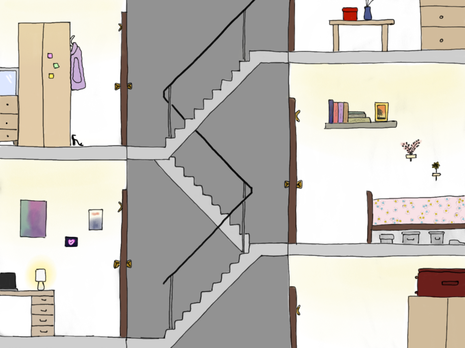An Article about Writing an Article
Scarlet Rowe talks through the typical process behind writing articles, and spots a curious correlation between her motivation to write articles and the proximity of her essay deadlines

Seeing as a significant portion of my lifestyle appears to consist of writing articles, I have come up with this absolutely genius idea whereby I will write an article (wait for it!) ... about writing an article.
Step 1
The first step to writing an article is to come up with an idea. Either section editors can do this for you on the Facebook commission pages, or you can do this for them by dropping an email. Up until recently, I’ve mostly responded to prompts for articles because my powers of original thinking are usually quite limited. However, once in a blue moon, I get divine inspiration and manage to think up an idea all by myself. And yes, I would like a medal for that, thanks for asking.
Step 2
“Once in a blue moon, I get divine inspiration and manage to think up an idea all by myself”
Once I have an idea of what I’d like to write about, I send in a pitch to the relevant section editors. This usually consists of bullet points and incoherent words which make a lot of sense in my mind but much less sense on paper (by which I mean email, but that has less of a ring to it). I then spend a good five minutes before sending the email wondering if ‘all the best’ is better than ‘all the best!’ or if ‘all the very best’ is actually the way to go. At the moment, I’m in an ‘all the very best!’ phase. I can’t tell if it’s too enthusiastic or not though?
Note to reader: sometimes my pitches get rejected, which I feel sad about for a minute or two before I decide that it’s their loss anyway. Right?
Step 3
“I usually forget how to write for a day or two before getting started”
If the editors like my pitch then I normally have a week or so to write the article. I usually forget how to write for a day or two before getting started. Then when I do get round to writing, I inevitably go on a number of tangents which I have to edit out. It usually takes me an hour or so to write the article, and then a sleepless night or two when I can’t figure if I should have put that comma there. Should it go here instead? Or what about here? And so the saga continues.
Plot twist!
I have recently discovered a very curious pattern whereby my motivation to write an article increases the closer I get to an essay deadline. I reckon that in such cases, my productivity multiples by at least three. I wonder why this is??
Step 4
Annoyingly, checking over articles is a must. I normally feel content to never look at my supervision essays again upon triumphantly adding the final full stop. But it is harder to do this with articles when the editors will catch you out if you don’t. Come to think of it, though, supervisors do this too. So maybe I (definitely) need to transfer some of my enthusiasm for article writing to my essays. And just in case you have any concerns that I will manage to turn my life around after all: I am fully confident that I will fail to act on this newfound resolution. I’m all words and no substance, you see.
Step 5
I normally send in my articles to editors at around 2 am in the morning aka my peak productive hour. Last week I sent in an article and was confused that there had been no response for a few days, until I realised that I had sent it to myself instead of the editor. That was awkward.
“The most irritating thing about responding to feedback is that editors are usually right”
Moving on swiftly, then; editors tend to respond within 48 hours. They usually say something ever so polite about how my article is ‘good overall’ but that a ‘few small changes’ need to be made before publishing. These ‘small changes’ can be anything from amending a few grammatical errors (:o) to rewriting the whole piece ‘from a slightly different angle’. The most irritating thing about responding to feedback is that editors are usually right. But, never fear! You are allowed to disagree with editors and fight for your right to that exclamation mark! I’ve disagreed with editors on several occasions and I haven’t been exiled from Varsity just yet.
Step 6
Once the editor(s) and I are relatively happy with the article (or – as is more likely – when they’re fed up of dealing with me), it takes a few days until it is published. On these days I usually forget that the article in question exists, and then end up being all too surprised if a friend messages me about it. What witchcraft is this? I wonder, until I realise that the article has been shared on the Varsity Facebook page, so no witchcraft is involved after all. Alas. When my article is online, I read through it and invariably think of a million and one things that I don’t like about it. The sentence I thought was funny is actually just a bit cringe. And the brackets I added to make for a friendly tone just look soOoO out of place.
Step 7
I comfort myself by thinking that one day I will be happy with an article I write. In fact, I decree that it must be so at 2 am as I set about writing my next pitch. This article, I assure myself, will be the articles to end all articles …
 News / Clare Hall spent over £500k opposing busway 24 December 2025
News / Clare Hall spent over £500k opposing busway 24 December 2025 News / Caius mourns its tree-mendous loss23 December 2025
News / Caius mourns its tree-mendous loss23 December 2025 Comment / The ‘class’ of Cambridge24 December 2025
Comment / The ‘class’ of Cambridge24 December 2025 Comment / Yes, I’m brown – but I have more important things to say22 December 2025
Comment / Yes, I’m brown – but I have more important things to say22 December 2025 Interviews / Politics, your own way: Tilly Middlehurst on speaking out21 December 2025
Interviews / Politics, your own way: Tilly Middlehurst on speaking out21 December 2025











